
![]()
Search the Journey to Forever website – click HERE
|
Journey to Forever: Make a donation |
Navigation
| Small farms library | |
| City farms | |
| Organic gardening | |
| Composting | |
| Introduction Compost and organics What is compost? |
|
| Making compost | |
| Good compost How not to fail Greens and browns Hints Compost containers Assembling the materials Adding liquids Batches Animal manure Sifting Cold weather |
|
| Composting resources | |
| Virtual composting Core texts General composting |
|
| Composting indoors | |
| Think small Filling the bin Problems Think even smaller Resources |
|
| Vermicomposting | |
| Vermicompost and plants The worms Breeding Worm boxes Dimensions Bedding Feeding Harvesting Problems Garden wastes |
|
| Vermicomposting resources | |
| Humanure | |
| Foundation work Modern developments Best of all! |
|
| Composting for small farms | |
| Foundation work On-farm composting resources |
|
| Small farms | |
Contact usTo Keith Addison Handmade Projects |
Composting
Garden guides often describe composting as "nature's way" of recycling. Not so -- you just don't ever find large amounts of organic matter with the correct carbon-nitrogen ratio, water content and aeration It's estimated that a human with a compost fork and a watering-can, carefully piling up organic matter with the correct C/N ratio, water content and aeration so that it cooks away at high temperatures and emits jets of steam, can make as much topsoil in a year as nature can make in a century, and nature definitely approves. You can tell when nature's happy, the plants smile at you. When she's not happy you can tell by all the "side-effects". Try it and see. Any gardener can quickly learn to make compost. Exceptions Soil maintenance is at the heart of organic growing: don't feed the plants, feed the soil -- the plants will look after themselves. The extremely complex subject of soil maintenance can happily be summed up in one word: composting. What lives, eventually dies, and its substance returns to the soil to be recycled into new life. This is nature's law of return. Organic growers greatly enhance the last part of the process by composting crop and other organic "wastes" before the soil receives them. Well-made compost is the ideal soil-food. "I know it sounds simplistic," says Keith, "but whatever problems you're having, the first solution is compost -- more and better compost. Pests or disease? Compost will fix that. Weeds? Compost will fix that too, along with mulching -- best of all, in permanent raised beds with fertile soil you can plant so close that the crops themselves form a living green mulch, maintaining a humid zone just above the soil. No weeds, no problems at all -- but it needs lots of good compost. Compost and CO2, Foodshare, Toronto -- "Not only does composting have agricultural benefits, it also combats climate change. When plant wastes are sent to landfills they turn into carbon dioxide and methane, two of the most common greenhouse gases. When those plants are composted, they lock up carbon from the atmosphere for decades! And when you compost and add that compost to your garden's soil, you are also sequestering additional carbon dioxide." "Here, for you gardeners who want to quantify your own contribution to the climate -- and for policymakers who'd like to reward farmers for climate-stabilizing behavior -- is how he went about it [estimating compost's carbon credits]. -- Donella H. Meadows, AlterNet, November 6, 2000 A smelly hole at the far end of the garden filled with putrefying kitchen wastes and flies buzzing round. That's what compost ISN'T. No stinks, no flies, though kitchen wastes are welcome.
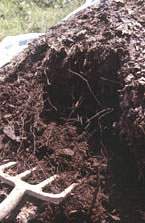 carefully piled up by bears or gorillas working away in the forests with a compost fork and a watering-can, leaving it cooking away at high temperatures and emitting jets of steam. Nature doesn't make compost. Nature mulches.
carefully piled up by bears or gorillas working away in the forests with a compost fork and a watering-can, leaving it cooking away at high temperatures and emitting jets of steam. Nature doesn't make compost. Nature mulches.
Composting is indeed a natural way of recycling, harnessing natural processes rather than machinery and man-made chemicals, but it takes people to do it.
You could argue that machinery and man-made chemicals, and indeed Genetically Engineered organisms and nuclear warheads also harness natural processes, and so they do, but you wouldn't claim they were "natural". "Natural" probably means something nature approves of. Does nature approve of compost, or is it a distortion of natural processes?
If you watch carefully to see what nature does as she goes about her daily round of chores, it's quite easy to start believing that the whole thing is a complicated, secretive conspiracy by soil micro-organisms to beget more soil micro-organisms. Nature's first concern is always to build more topsoil, and to protect it. It's easy to see why: no topsoil, not much nature either. The Earth's green carpet of living things is really just the Soil Creature's skin.
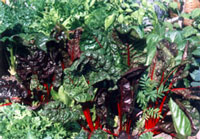
Healthy plants growing well with plenty of good compost at the Journey to Forever organic garden
A single spade full of rich garden soil contains more species of organisms than can be found above ground in the entire Amazon rain forest.
Although the soil surface appears solid, air moves freely in and out of it. The air in the upper 8 inches of a well-drained soil is completely renewed about every hour.
-- Soil Factoids, US National Soil Survey Center
-- "Man's work with Nature that furthers Nature's aims is the work that rewards him the best." (I-Ching)
It's not quite true that nature never makes compost. There's an Australian bird that carefully assembles large piles of organic matter to nest on, mixing it up with droppings -- arguably a compost pile. It even generates warmth, which helps to hatch the eggs. And termites build tiny compost piles deep underground from pulped wood to make the special soil needed for the fungus farms that produce the only food they can eat. Sometimes there are even manure worms in attendance at the compost site. Termites could be the world's most scientific composters.Compost and organics
-- "Producing quality compost is the most important job on the organic farm. A lot of the problems I see on farms I visit could be solved by making better compost." -- Elliott Coleman, The New Organic Grower
 This is how impoverished, sick soils can be restored and maintained at high levels of fertility.
This is how impoverished, sick soils can be restored and maintained at high levels of fertility.
The cycle of growth and decay is often depicted as a wheel, where birth, growth and maturity take place above ground in the light, and the processes of decay below the surface in the darkness, giving birth to life anew. If growth is faster than decay the wheel is broken, destroying nature's balance. Composting accelerates the decay process while maintaining the balance of the wheel -- growth follows automatically as the wheel spins faster.
-- "Growth has been speeded up, but nothing has been done to accelerate decay. Farming has become unbalanced. The gap between the two halves of the Wheel of Life has been left unbridged, or it has been filled by a substitute in the shape of artificial manures (chemicals). The soils of the world are either being worn out and left in ruins, or are being slowly poisoned. The restoration and maintenance of soil fertility has become a universal problem." -- Sir Albert Howard, Farming and Gardening for Health or Disease (The Soil and Health), Faber and Faber, London, 1945
"Not enough water? Drought? Compost will fix that as well -- it greatly increases the soil's water-holding capacity.
"Too much water? I had an old rice field that was so badly clay-panned from years of overashing that it was still waterlogged after four months without rain, only rank grass would grow there. Compost and weeds fixed it. I cleared it and sowed a lot of wild sunnhemp seeds, and compost gave them a start.
Those deep roots went down right through the pan. The villagers thought I was crazy -- I had the best crop of weeds in the valley. But sunnhemp's good fodder for livestock, and good compost material, and it's a legume so it fixed lots of nitrogen in the soil. You could grow anything in that field after that."
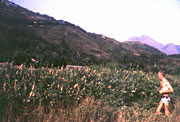
The best crop of weeds in the valley
What a useful weed!
Sunnhemp -- Crotalaria juncea (James A. Duke, 1983, Handbook of Energy Crops, Purdue)
http://www.hort.purdue.edu/newcrop/duke_energy/Crotalaria_juncea.html
100-Year Drought Is No Match for Organic Soybeans
KUTZTOWN, Penn. (November 8, 1999) -- After one of the worst droughts on record, the harvest for many farms in the US has been a disaster. But one farm is celebrating: "The yield from our organic soybeans is outstanding," says Jeff Moyer, Farm Manager at The Rodale Institute's Farming Systems Trial in Kutztown, Pennsylvania. Using replicated plots the trial compares highly productive, intensive soybean systems under conventional and organic management. Figures just released show yields of 30 bushels per acre from the organic soybeans compared to only 16 bushels per acre from conventionally-grown crops. Improved soil quality under organic management is credited for the high performance of Rodale's organic crops in the drought.
http://rodaleinstitute.org/global/11_9_99.html
See:
Brix levels
No sugar
Compost and CO2
http://www.foodshare.net/garden13.htm
How Much Greenhouse Gas Does Your Garden Cut?
"'The biggest uncertainty relates to how deep the organic matter is going into the soil. I assume that the change in soil organic matter is confined to the top 8 inches. I suspect that you're actually leaching humus into deeper soil, which would affect the result a lot. So this is a conservative estimate.'
A silt-loam soil weighs roughly 85 pounds per cubic foot. Eight inches of it weighs 56 pounds per square foot. Organic matter is about 58 percent carbon. So soil with one percent organic matter contains (hmmm, one percent of 58 percent of 56 pounds) 0.3 pounds of carbon per square foot. Soil with 7.7 percent organic matter contains 2.5 pounds of carbon per square foot. David and Judy have increased the amount of carbon in every square foot of their garden by 2.2 pounds. It's a big garden, 0.4 acres. (Actually it's a communal garden, which David and Judy share with their neighbors.) That's 17,424 square feet. Multiply by 2.2 pounds of carbon per square foot -- let's see here -- that makes over 38,000 pounds of carbon removed from the atmosphere -- 19 tons!
Jon writes to David: 'You have sequestered 19 tons of carbon into your garden over the last 10 years. This is impressive! The average American releases 6 to 6.5 tons of carbon into the atmosphere each year. So you have offset about three years of an average American's emissions.'
http://www.alternet.org/story/10050/?page=entire
Heavily composted soil with a high organic matter content will sustain much more growth than poor soil with a low organic matter content, sequestering yet more carbon in all the green stuff growing above the soil as well as in the extra humus beneath the surface.
It's a greening problem: we have to green everything, or re-green it. Greening cities, greening rooftops, greening wasteland, with city farms and community farms, composting and recycling all organic wastes, and greening everything else too.
Make compost and grow food.
See:
Greenhouse gases and global warming
What is compost?
Compost is not just decayed organic matter. Composting is applied microbiology at its most complex, involving the interactions of thousands upon thousands of different species of microorganisms (2 million individuals per gram) in a highly complex ecosystem. The composting process kills weed seeds and suppresses human and plant pathogens; that doesn't happen when leaves and other detritus rot down on their own.
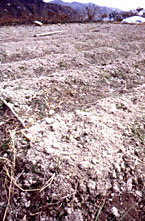
Worn-out soil, grey and lumpy
Once applied, compost "balances" the soil flora: that is, for each of the scores or more of disease organisms that can affect each species of plant, at least 12 to 15 different species of bio-control microorganisms need to be present, with the food and conditions they require, if the plant is to be healthy. Composting accomplishes that, among other things.
For more about soil microorganisms and the vital role they play, see "The Living Soil: Importance of Soil Organisms" in the Sustainable Soil Management Soil System Guide by the Appropriate Technology Transfer for Rural Areas (ATTRA) in the US:
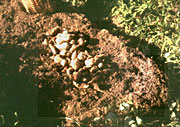
The same soil tranformed, after a very light composting and a sweet potato crop (shared with a family of bandicoots, but there was plenty for everyone)
"One of the major benefits bacteria provide for plants is in helping them take up nutrients. Some species release nitrogen, sulfur, phosphorus, and trace elements from organic matter. Others break down soil minerals and release potassium, phosphorus, magnesium, calcium and iron. Still other species make and release natural plant growth hormones, which stimulate root growth.
"A few species of bacteria fix nitrogen in the roots of legumes while others fix nitrogen independently of plant association. Bacteria are responsible for converting nitrogen from ammonium to nitrate and back again depending on certain soil conditions. Other benefits to plants provided by various species of bacteria include increasing the solubility of nutrients, improving soil structure, fighting root diseases, and detoxifying soil."
Other soil organisms covered: earthworms, arthropods, fungi, actinomycetes, algae, protozoa, nematodes (mostly beneficial): "All these organisms -- from the tiny bacteria up to the large earthworms and insects -- interact with one another in a multitude of ways in a whole soil ecosystem." Total weight of soil organisms per acre of healthy topsoil: about 4 tons.
http://www.attra.org/attra-pub/soilmgt.html#organisms
Real composting has been a scientific process since the 1930s. In fact it's nothing new -- the Spanish Arabs were master composters, and Chinese peasants have composted virtually everything for centuries. But science has made it a simple matter -- just follow the recipe. See Making compost.
See Vermicomposting resources for more information.
City farms
Organic gardening
Building a square foot garden
Plant spacing guides
No ground? Use containers
When to sow what
Seeds
Garden pond
Gardening resources
Composting
Making compost
Composting resources
Composting indoors
Vermicomposting
Humanure
Composting for small farms
Small farms
Small farm resources
Community-supported farms
Farming with trees
Farming with animals
Pasture
Pigs for small farms
Poultry for small farms
Aquaculture for small farms
Composting for small farms
Controlling weeds and pests
Small farms library